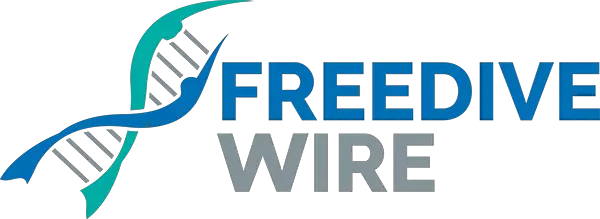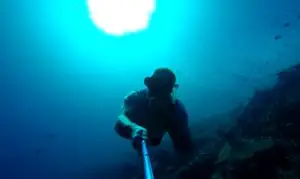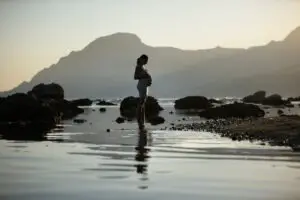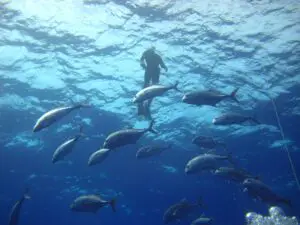What follows is @wrick’s review of the Performance Freediving International (PFI) advanced course, including safety supervisor and Diving Alert Network- Diving Emergency Management Provider (DAN DEMP) course. The course was taught along the Kona coast, Jack’s diving locker and Honaunau by instructors Kirk Krack and Shelby Eisenberg, with Chris Bustad, Charles Beddoe and a guest appearance on the line by John Hullverson. Photo above is @wrick with a school of Akule by Wayne Levin.
How I started freediving
I first travelled to Kona to learn freediving in 2002 or so. I was a SCUBA diver who heard about freediving and had read Carlos Eyles books: Last of the Blue Water Hunters, Secret Seas and The Blue Edge. Before ever feeling a contraction during statics or squeezing into my first open cell wet suit I was hooked. My first formal instruction, it should be said, wasn’t very formal at all. Carlos’ instructions on how to freedive were more about watching, paying attention and listening. It was learning by immersion and it was amazing. We would go to places along the Kona coast, jump in and spend a couple hours in search of Manta or fish to take pictures of. Other divers would join us. I met Brett Lemaster on one of those dives, who was a former world record holder in the discipline of constant weight. His record was 81 m and the way he moved up and down through the water column looked effortless. Also on that trip I met an underwater photographer named Wayne Levin whose black and white images of body surfers and giant schools of Akule are extraordinary.
http://waynelevinimages.com/fish-schools/
http://waynelevinimages.com/surfers/
Wayne and I have stayed in touch and I got to dive with him again on this trip. He is still one of the friendliest fellows you will ever meet and he still shoots analogue.
After my immersion with Carlos in ’02 I went home to the cold waters of BC and due to a number of factors I wasn’t able to continue diving. A few years ago I got the itch back and returned to Kona to take instruction with Freediving Instructors International. It was my first formal training and I learned so much. I went on to participate in their week long Kona camp and had a great time making great friends (Team Zissou from Maui remain great dive pals).
I wanted to continue learning and knew that Performance Freediving International was based out of Campbell River and so I thought that it might make more sense to continue learning with a local outfit. I took an Intermediate course in Vancouver with Kirk and Shelby and knew that sometime soon I would want to try the advanced.
Now I should say that while I am very comfortable in and under the water I haven’t necessarily found freediving easy. I have had some challenges with equalization and sinus issues that have sometimes held me back and before my advanced course hitting 25 m in Vancouver was all I could handle. My expectations for the advanced were therefore a bit muted.
In order to pass the course you need to demonstrate proficiency in the many different safety protocols, pass a full day DAN Diving Emergency Management Provider course and fulfill the depth requirements. The days were long and the expectations high but the one area I was sure I wouldn’t pass were the depth requirements. In order to pass the course you need to do a pull down to 40m demonstrating good technique and a 40 m CWT with good technique. I was pretty sure that wasn’t going to happen. My goals were to learn all the advanced safety skills, advance my understanding of equalization techniques and if I was to hit a strong 30 m I would be a very happy guy.
Our class was full, I think there were 9 of us all together. The days were long. I was exhausted all of the time. The travel to and from our open water site could seem a bit frantic at times due to the amount of material we had to cover in class and pool before heading to Honaunau which is a 30 min drive away from Jack’s.
Everything was taken to a new level. In the morning we would cover theory practicing new skills like advanced breathing and equalization techniques and the many safety skills we would have to know for the Safety Supervisor part of the class. In the late morning we would hit the pool where we were expected to be proficient with many different rescue scenarios. In the afternoon we would go to the City of Refuge and Honaunau for open water to work on our depth training. Lanyards and neck weights were employed along with primary and secondary safety so at first it was a lot to keep track of. And it was all new to me. Am I at the clutch? Ohhh right I am primary safety. Wait… somebody grab that pool noodle before it floats away. I won’t soon forget my first dive on the line with lanyard, breathing up on my back with pool noodles under my neck and behind my knees- four pounds of lead shot around my neck I remember thinking-this feels a lot more like sky-diving than freediving. The stakes seemed higher with all the new equipment and techniques to become acquainted with. It is here that our very skilled, patient, confident, encouraging instructors were at their best. Charles and Chris guided us through all of these new skills and responsibilities while Kirk or Shelby were focusing on overseeing most of the time. A note on all of the instructors. I think they have a different motor running in there than I have in here. Dives to 40 m and beyond over and over is extremely energy intensive. I actually have no idea how they manage. But they did all this and more (retrieving the odd snorkel or fin for example) while maintaining an exacting standard for themselves as far as modeling great safety skills, great diving, and super teaching. If you are still reading this then I presume you have more than a passing interest in freediving and so you know how tricky it can be to sort out what is up with your equalizations, hard and soft kick cycles, sink phase, head position, timing for rescue scenarios, it goes on and on and it seems every time I was up against some issue there would be two or three super helpful suggestions from any of the instructors. I think that was reassuring too. At first your instinct is to rely on Shelby or Kirk as they were the Advanced Instructors but it took no time at all to figure out that any of the people out there on the line representing PFI had a tonne of knowledge and were very good at helping you incorporate it.
Did I mention that I have a bleeding disorder? No? Well if you are interested in reading about freediving for someone that is prone to excessive bleeding you should follow this link. I bring it up because in the past my health issues have caused some confusion and concern with freediving instruction. What I would like to appreciate PFI for is a general comfort with my medical condition that I hadn’t experienced before.
It seems that it is important to PFI to make the sport accessible to anyone who wishes to experience what it is like to be weightless and free of the indignities that gravity imposes on those of us with mobility issues for example. I have lost the ability to participate in most land based recreational activities due to lifelong bleeding into my ankles. PFI has enabled me to freedive to my hearts’ content.
Did I make it to 40 m? No. But I hit 35 CWT and a 5:30 static which for me was everything I could have hoped for. None of my instructors paid lip service to the idea that it isn’t about the depth or time, it’s about the process, the technique, the safety. Being comfortable before progressing. Every one of us regardless of how our depth training was going that day was made to feel good about where we were. And, hey, you can see 40 from 35 right?
See you out there.






Really nice article Rick.